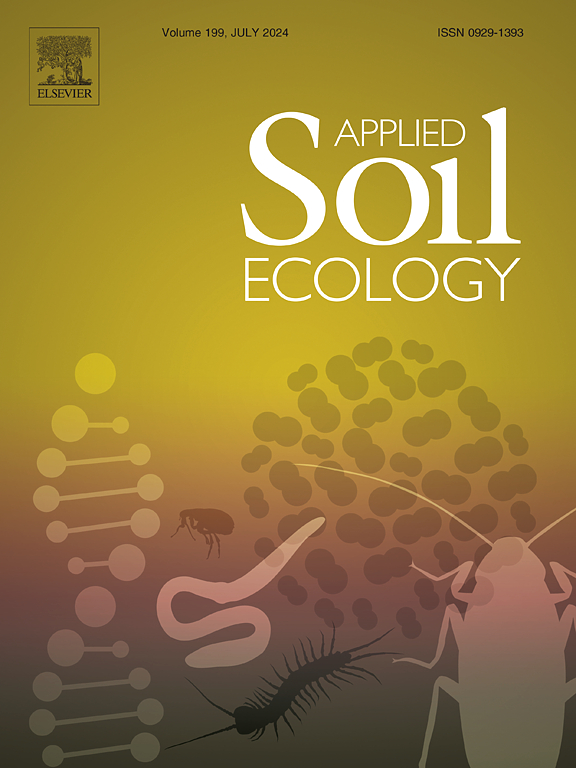植保产品应用对土壤微生物氮循环功能的影响尚未被基因定量完全捕获
IF 5
2区 农林科学
Q1 SOIL SCIENCE
引用次数: 0
摘要
植物保护产品(PPPs)在农业中的广泛使用引起了人们对其对土壤健康和氮循环的长期影响的担忧。目前的监管评估主要集中在单一活性成分和微生物矿化上,忽视了配方ppp的复杂性及其对微生物功能的影响。通过对照培养实验,研究了PPP对土壤氮循环的影响,并通过增加PPP强度,测量潜在硝化作用(PN)、反硝化酶活性(DEA)和N₂O还原能力(NRC),以及参与N循环的关键微生物基因的分子分析。与基因丰度相比,功能测定对PPP暴露更敏感,表明氮循环受到严重破坏。在测量过程中,PN对ppp最敏感,在处理过程中显示出显著的降低。DEA和NRC也被强烈抑制,表现出复杂的时间模式。古菌和细菌氨单加氧酶(amoA)基因丰度与PN、亚硝酸盐还原酶(nirK)基因丰度与DEA呈显著正相关,而基因丰度的响应性较弱。我们的发现强调了整合分子和功能指标的更新风险评估的重要性。我们提出了一种分层的方法,使用基因量化作为初始筛选工具,然后进行功能分析以捕获生物学相关的变化。在现场条件下对公私伙伴关系混合物进行注册后监测对于解决累积和长期影响同样至关重要。总体而言,本研究突出了土壤N循环对PPP暴露的脆弱性,并为加强旨在保护土壤生态系统功能的环境风险评估提供了框架。本文章由计算机程序翻译,如有差异,请以英文原文为准。

Impact of plant protection product applications on soil microbial nitrogen cycle function not fully captured by gene quantification
The widespread use of plant protection products (PPPs) in agriculture raises concerns about their long-term impact on soil health and nitrogen (N) cycling. Current regulatory assessments focus mostly on single active ingredients and microbial mineralisation, ignoring the complexities of formulated PPPs and their influence on microbial functions. We investigated the effects of realistic PPP application scenarios on soil N cycling using a controlled incubation experiment with increasing PPP intensities, measuring potential nitrification (PN), denitrifying enzyme activity (DEA), and N₂O reduction capacity (NRC), alongside molecular analyses of key microbial genes involved in N-cycling. Functional assays were more sensitive to PPP exposure than gene abundances, indicating severe disruptions to N cycling. Among measured processes, PN was the most PPP-sensitive, showing substantial reductions across treatments. DEA and NRC were also strongly inhibited, exhibiting complex temporal patterns. While gene abundances were less responsive, there were significant positive correlations between the gene abundance of archaeal and bacterial ammonia monooxygenase (amoA) and PN, as well as between nitrite reductase (nirK) and DEA. Our findings underscore the importance of updated risk assessments that integrate both molecular and functional indicators. We propose a tiered approach, using gene quantification as an initial screening tool, followed by functional assays to capture biologically relevant changes. Post-registration monitoring of PPP mixtures under field conditions is likewise essential to address cumulative and long-term impacts. Overall, this study highlights the vulnerability of soil N cycling to PPP exposure and provides a framework to enhance environmental risk assessments aimed at safeguarding soil ecosystem functions.
求助全文
通过发布文献求助,成功后即可免费获取论文全文。
去求助
来源期刊

Applied Soil Ecology
农林科学-土壤科学
CiteScore
9.70
自引率
4.20%
发文量
363
审稿时长
5.3 months
期刊介绍:
Applied Soil Ecology addresses the role of soil organisms and their interactions in relation to: sustainability and productivity, nutrient cycling and other soil processes, the maintenance of soil functions, the impact of human activities on soil ecosystems and bio(techno)logical control of soil-inhabiting pests, diseases and weeds.
 求助内容:
求助内容: 应助结果提醒方式:
应助结果提醒方式:


